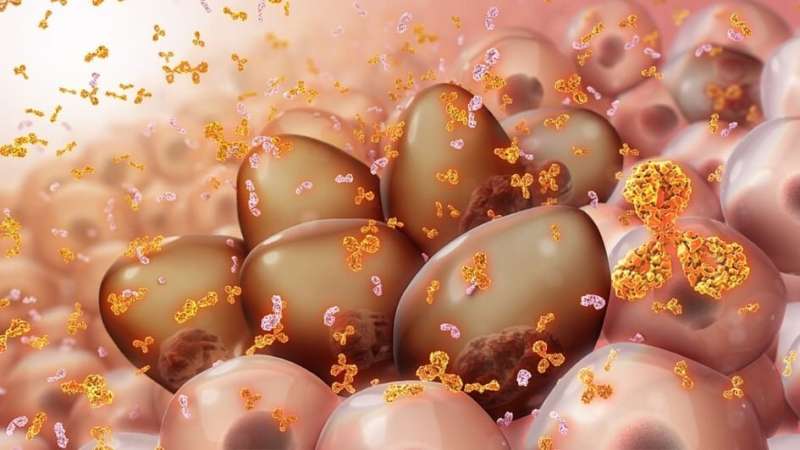
Scientists have found a new way to predict which patients with the blood cancer myeloma will benefit the most from a treatment often used to help keep the disease from coming back after a stem cell transplant.
For people with certain high-risk genetic features in their cancer cells, the drug, called lenalidomide, cut their risk of seeing their cancer progress or dying by up to 40-fold.
The research, led by scientists at The Institute of Cancer Research, London, in collaboration with the clinical trials unit at Leeds University, suggests that myeloma patients should be genetically tested at diagnosis, so that those most likely to benefit from lenalidomide can be identified—helping tailor treatment to the needs of each patient. The study is published in the journal Blood.
High-risk genetic features
Previous research has shown that around one quarter of myeloma patients have various high-risk genetic features. These genetic features can make the cancer more aggressive, less responsive to treatment and likely to relapse more quickly.
In this study, researchers at The Institute of Cancer Research (ICR) analyzed data from 566 patients from the Myeloma XI trial, which aims to evaluate the effectiveness of a range of targeted drugs, including lenalidomide, in people with newly diagnosed myeloma.
Out of the 556 patients on the trial, 17% had so-called “double hit” myeloma (meaning they had two or more high-risk genetic features), 32% had only one high-risk genetic feature, and 51% had no high-risk markers.
Some patients with single-hit markers benefitted the most
ICR researchers analyzed these groups and found that some single-hit myeloma patients benefitted the most from lenalidomide maintenance therapy after a stem cell transplant—specifically, those with three different genetic abnormalities known as del(1p), del(17p) or t(4;14).
These patients had an up to 40-fold reduced risk of cancer progression or death, compared to those on observation alone.
Patients with one of these “single-hit” genetic abnormalities lived longer on lenalidomide maintenance therapy—for an average of 57.3 months (almost five years) before their disease progressed, compared to 10.9 months for those on observation alone.
Those with “double hit” or no high-risk genetic markers also saw some benefit from lenalidomide. They had around a two-fold reduced risk of disease progression or death compared to observation, respectively. However, patients with a different “single-hit” genetic marker known as gain(1q) seemed not to derive consistent benefit from lenalidomide, suggesting this group may be more complex than others.
These findings strongly support the use of lenalidomide in myeloma patients who have undergone a stem cell transplant, especially those with single-hit high-risk markers like del(1p), del(17p) or t(4;14)—as well as the use of routine genetic testing in people with myeloma, to identify those most likely to benefit from different treatment strategies.
‘Genetic testing should be routinely used’
Study leader Dr. Martin Kaiser, Team Leader in Myeloma Molecular Therapy at The Institute of Cancer Research, London, and Consultant Hematologist at The Royal Marsden NHS Foundation Trust, said, “We have found a new way to predict which patients with newly diagnosed myeloma are most likely to benefit from the cancer drug lenalidomide after undergoing a bone marrow transplant.
“We believe that genetic profiling should be routinely used in myeloma treatment. Knowing which high-risk genetic features are present in each cancer can help us make the best choices when it comes to people’s treatment—ultimately leading to more personalized care.”
‘It really gives me good peace of mind’
Cecelia Brunott, 46, from Farnham, was diagnosed with myeloma in 2020. She has been taking lenalidomide, following a bone marrow transplant, since September 2021. She said, “My doctor recommended lenalidomide, as it has been shown to keep myeloma at bay for longer after a bone marrow transplant. It has little side effects and can really improve the quality of life of people living with cancer.
“Since myeloma is currently not curable, the hope is to get it in remission and to keep it that way for as long as possible. It’s a difficult time, as you never know when the cancer might come back, so it really gives me good peace of mind to know that the drug is doing its thing and helping keep the cancer away for a longer period of time.
“My cancer protein levels have come down since being on lenalidomide maintenance, and since March 2022 they are no longer measurable. I hope this will remain the case for a long time.
“My myeloma cells were genetically tested and, as far as I’m aware, I have no high-risk markers. I think it is very important for everyone with myeloma to be tested and to be aware of any high-risk markers, so that they can get access to the best treatment for them.”
‘This research is absolutely vital’
Study author Gordon Cook, Professor of Hematology in the University of Leeds’s School of Medicine, said, “These interesting findings give us a greater understanding of how genetic testing can be used in cancer research, which one day may translate into personalized treatment for multiple myeloma patients.”
Shelagh McKinlay, director of research and advocacy at blood cancer charity Myeloma UK, said, “This research is absolutely vital and brings us closer to a more personalized approach to treatment, which is key for myeloma patients as it is such an individual cancer.
“Sadly, despite many scientific and medical advances in recent years, survival outcomes for people with high-risk myeloma are still poor. This research is helping us to understand which patients will benefit most from a particular treatment, giving hugely disadvantaged patients a better chance to survive the disease longer and to have a good quality of life.”
More information:
Sarah Anne Bird et al, IMiD Resistance in Multiple Myeloma: Current Understanding of the Underpinning Biology and Clinical Impact, Blood (2023). DOI: 10.1182/blood.2023019637
Journal information:
Blood
Source: Read Full Article
